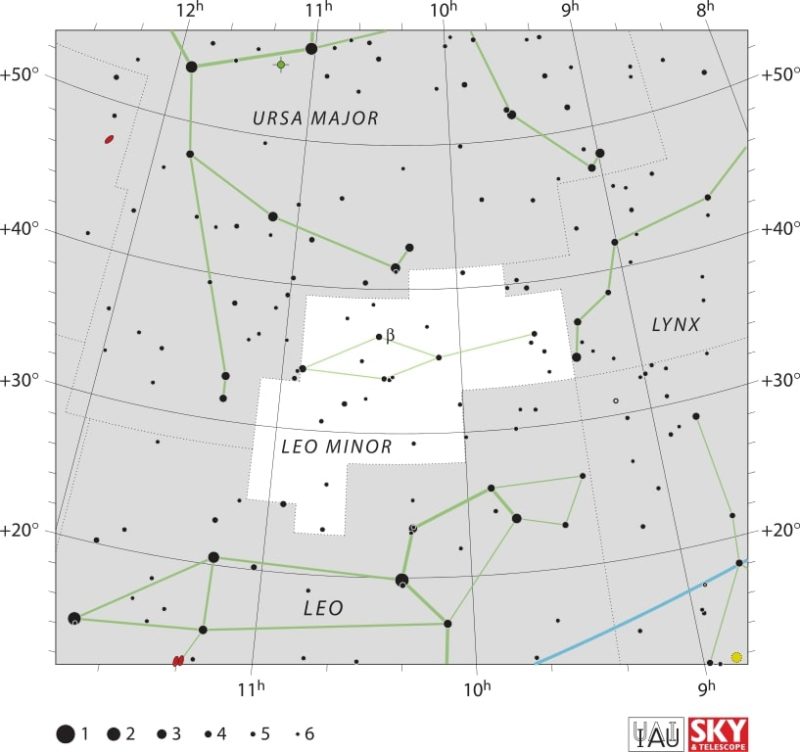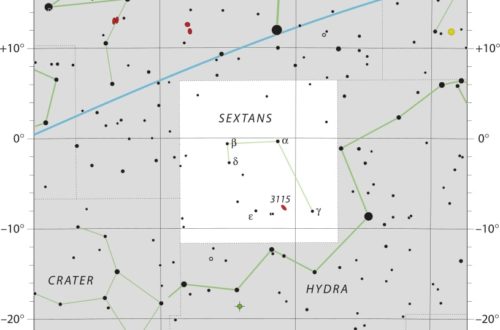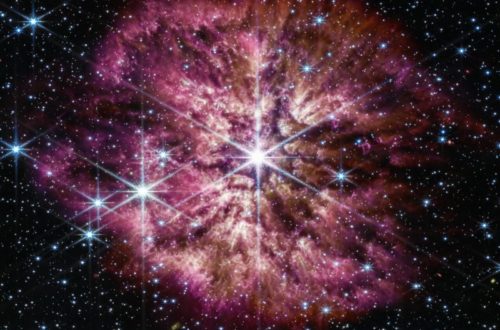Leonis Minorid Meteor Shower Guide

The Leonis Minorids are an obscure meteor shower that often goes unnoticed, peaking every year on October 24. It comes from the constellation of Leo Minor.
At its peak, most years, the Leonis Minorid meteor shower delivers a pretty minimal display, with just two meteors per hour. It is not always quiet and can often shock stargazers with dramatic outbursts of activity. The shower’s meteors are all quite fast (62 km/s), frequently producing bright, quick streaks of light that vanish in a few seconds.
What Are Leonis Minorids?
Beyond their subtle beauty, the Leonis Minorids are an interesting meteor shower. They get their name from the constellation Leo Minor—a small and easily missed patch of sky in the northern celestial hemisphere.
Unveiling the Faint Shower
In fact, the Leonis Minorid meteor shower fall as one of the weaker meteor showers. They rarely boast a zenithal hourly rate (ZHR) higher than a measly 2 meteors per hour. This makes them a difficulty, even for experienced skywatchers.
Their meteors can be quite faint themselves, easily washed out by the light of the city or a full moon. To have any hope of seeing them, observers will require dark, clear skies—and plenty of patience. The radiant point, or the point in the sky where the meteors seem to come from, glimmers in the constellation Leo Minor.
When done correctly, this strategy greatly increases your odds of success. Similar to other, better-known showers, the Leonis Minorids don’t have a spectacular display. Rather, they gratify the most observant among us—the ones who appreciate the solemnity and stillness that is part of taking in a delicate, otherworldly display.
The Parent Comet Connection
All meteor showers come from somewhere. For the Leonis Minorids, astronomers think it’s from a long-period comet (likely comet C/1739 K1) but are still working to determine which one for sure. Meteor showers are created when Earth travels through streams of debris that comets or asteroids leave behind in the solar system.
As these particles of rock and dust collide with the Earth’s atmosphere, they burn up and produce bright meteors in the night sky. For meteor science, knowing the parent comet is key. It shows us a lot about the composition of the debris and the comet itself.
The parent body of the Leonis Minorid meteor shower is less well understood than those of larger showers. Current research is still trying to get to the bottom of this mystery. As we keep tracking the shower’s path and timing, we will likely one day be able to link it to a specific comet.
Understanding this connection can enhance our understanding of the solar system’s evolution.
Why “Leonis Minorids”?
There’s a logic to naming conventions in astronomy. The Leonis Minorids are named after the position of their radiant which lies in the constellation of Leo Minor. This system is very useful when identifying different showers, since many showers are active at the same time of year.
The suffix “-ids” denotes the source as the constellation, and since “Leonis Minor” translates to it coming from Leo Minor. This is more than a philosophical debate over terminology. This makes it easier for astronomers to track and categorize meteor showers, enabling further research and observation.
Leo Minor is a pretty dim constellation. It’s where it resides on the celestial map that gives the Leonis Minorids their character.
Distinguishing From Leonids Major
The Leonis Minorids are often confused with their more popular cousins, the Leonids. These two meteor showers are different in some important respects.
The Leonids, associated with the constellation Leo, are known to produce more spectacular meteor storms. At their best in peak years, they’re capable of dazzling display rates, exceeding even 100 meteors per hour! The Leonis Minorids, in contrast, are pretty tame, with just a handful of meteors per hour at their peak.
A Minor Shower’s Charm
There’s definitely something exciting that comes with minor meteor showers such as the Leonis Minorids. The shower can be underwhelming because of its low numbers. Each meteor is like a reward for your patience and dedication.
Catching elusive meteors on an invigorating October evening provides a delightful and meditative experience as you immerse yourself in the vastness of the cosmos. That excitement of witnessing even a single meteor when activity is expected to be low lends itself to a feeling of exploration and discovery.
Radiant Point Location Details
The Leonis Minorids radiate from the constellation Leo Minor, a dim northern constellation located just above Leo.
For precise location, we recommend using a star chart or astronomy phone app to help identify where Leo Minor is located. Understanding where to look can ensure that the meteors you’re seeing are from this shower and not one of its close neighbors.
Familiarizing oneself with the shape of Leo Minor will prove helpful for naked-eye observers. Its subtlety is what can make it difficult to identify without the right preparation.
Typical Meteor Speed Data
Leonids Minorids meteors pour in at an average speed of 62 km/s—very fast even by meteoric standards. This high speed ensures that their trails are speedy and bright, but typically fleeting.
Faster meteors will be harder to catch, so being attentive is essential. The excitement of experiencing a meteor darting above at that speed gives the annual meteor shower an exhilarating boost.
Understanding Zenith Hourly Rate (ZHR)
Understanding Zenith Hourly Rate (ZHR) is important for meteor watchers. The Zenith Hourly Rate, or ZHR, is a measure of how many meteors you would see if conditions were perfect. In the case of the Leonis Minorids, the ZHR is usually around 2.
These figures are useful in establishing expectations. It’s a thin shower, to be savored with some patience and away from glare-filled areas.
Shower Activity Window Annually
To put that in perspective, this shower lasts from October 19th to October 27th. Look for it to peak on October 24. The seasonal sky transition brings with it cooler nights and clearer skies, making fall a welcoming time for meteor-watching.
Scheduling your observations for when there will be peak activity or when Leo Minor is highest in the sky provides the greatest opportunity to see activity.
Observing the Leonis Minorid Meteor Shower Successfully
Follow these tips to make the most of your Leonis Minorid meteor shower experience. Prepare with the proper knowledge and plan your viewing to optimize your experience.
Below are key strategies and tips for making your viewing session worthwhile, along with practical advice on timing, location, and gear.
Finding Dark Skies Near You
- See maps from the International Dark-Sky Association to find certified dark sky parks and reserves.
- Check online resources such as Dark Site Finder and Light Pollution Map to identify dark-sky locations within traveling distance of your home.
- Look for nearby rural parks, state forests, or other public lands where light pollution is less present.
- Consider joining local astronomy clubs or groups—many host or plan group trips to established dark sky sites.
- Inquire about any local “star parties” or community skywatching events which are beginner-friendly and open to the public.
Light pollution from urban areas is the greatest challenge to meteor observers, particularly within 50 km of major cities. Choosing a location well away from the blinding urban glow will make all the difference in the world.
Just a 30-minute drive outside of town may open up a vastly improved sky. Apps and online resources guide you as you compare locations, but clubs provide on-the-ground knowledge and fellowship on your journey.
Essential Gear (Or Lack Thereof)
- Warm clothing (layers, hat, gloves)
- A reclining lawn chair or blanket
- Thermos of hot drinks
- Red-filtered flashlight
- Snacks and water
Meteor watching isn’t about high-tech equipment. The best experience for most observers comes with the use of only their eyes, ensuring a clear view, and keeping comfort in mind.
Having a comfortable chair or blanket-friendly spot allows you to settle in and observe for extended periods. Wear warm clothing, as nights can be quite cold, even in warmer climates.
Don’t be tempted by binoculars or telescopes—they’ll restrict your field of view too much and you won’t need them for meteors.
Tips for Patient Skywatching
Be calm and give your eyes time to adapt to the darkness. Take someone with you, or try to find a group—talking about what you’re seeing will make the wait easier. If you begin to feel sore or fatigued, take a moment to stretch or rest.
Since the best sightings are sometimes the most surprising, we recommend being vigilant even on days where the sky looks boring.
The meteors are typically a bit fainter than sporadic meteors, but even just one bright streak is worth the patience.
Conclusion
The Leonis Minorids appear annually at a moderate rate, with no high-profile display. The shower won’t draw the huge throngs like the big events. It provides a subtle happiness for anyone who loves the aesthetic of the sky.
Out in the crisp autumn air, good eyes can see them from Leo Minor. No special equipment is required, just a dark piece of sky and a willingness to wait. An evening spent watching the Leonis Minorids can transform an otherwise ordinary night into one of the coolest experiences you’ll have to reminisce about.
Plan a trip, ideally with a group, and take bets on who’s going to catch the first lightning flash. Sometimes the best things are hidden in the most mundane. Stay tuned for the next batch and watch what soars!
Frequently Asked Questions
What are the Leonis Minorids?
The Leonis Minorids are a very minor meteor shower that is visible every Autumn. They appear to stream from the constellation Leo Minor, which is ideally located for viewing in the Northern Hemisphere.
How many meteors can I expect to see?
The Leonis Minorids are a small shower. You can expect to see about 2 meteors per hour at peak activity, under ideal dark-sky conditions.
Do I need special equipment to see the Leonis Minorids?
No. All you require is your own eyes. For optimal performance, allow them to acclimate to the darkness for 20–30 minutes. You do not need telescopes or binoculars.
What causes the Leonis Minorids meteor shower?
The shower is produced when Earth passes through debris left by a comet. When these small particles collide with our atmosphere, they produce meteors as they disintegrate.
Why should I watch the Leonis Minorids?
Viewing the Leonis Minorids will be a calm and relaxing experience, perfect for spending time under the starry sky. While it may be a small shower, the Leonis Minorids presents a wonderful opportunity for avid stargazers and families alike.
See also:
- Previous meteor shower: Orionid Meteor Shower
- Next meteor shower: Northern Taurid Meteor Shower
Would you like to receive similar articles by email?





